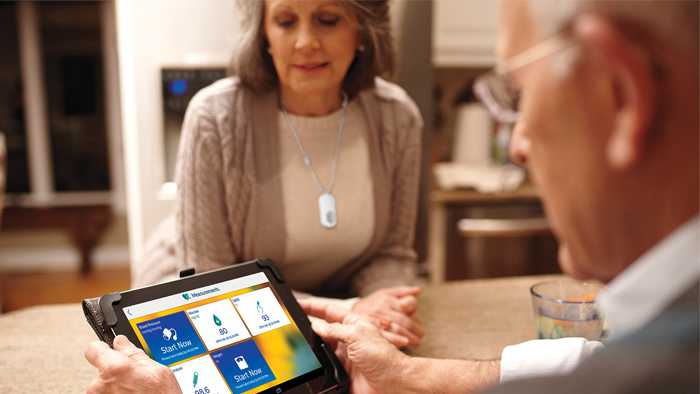How digital technology can improve access to care by removing social barriers
In recent years, universal health coverage (UHC) has emerged as a central imperative of the World Health Organization (WHO), the United Nations and most of its member states. Leaders from across the world came together during the United Nations General Assembly (UNGA) in New York to discuss this pressing issue, among many other things. The notion of UHC is not new. In fact, it dates back to Otto von Bismarck, who established the world’s first national social health insurance system in Germany in 1883 [1]! So, almost 140 years later – where are we now? According to a report published in 2017 by the WHO and the World Bank, up to 3.5 billion people – half the world’s population – still don’t receive the health services they need [2]. And there is an important fact that is often overlooked: while lack of access to care is obviously most pressing in low- and middle-income countries and we should focus on improvements in these areas, it is also a matter of concern in the industrialized world. That is possibly even more unforgiveable – how can it be that countries that actually have all the elements needed to solve this problem, are not capable of doing so? Is it the system? The (un)willingness to work together? The challenges that come with transformation?

Panel discussion "Going Digital: Creating enabling ecosystems for digital health" on September 24, 2019 at Devex’ UHC Pavilion during the UNGA in New York where I underlined our commitment to Universal Health Coverage. From left to right: Jan Kimpen, Global Chief Medical Officer at Philips; Irene Koek, Acting Assistant Administrator, Global Health Bureau, USAID; Steve Davis, CEO, PATH; Bernardo Mariano Jr., CIO, WHO; Catherine Cheney, West Coast Correspondent, Devex.
Access to care and social determinants of health
In the US, for example, with high standards of healthcare, the number of people without health insurance increased from 25.6 million – or 7.9% of the population – in 2017 to 27.5 million – or 8.5% – in 2018 [3], mainly because they can’t afford it. And being uninsured can have serious implications – if you have an emergency, you will be treated, but with a big bill for incurred expenses afterwards, and you won’t be able to get proper supervision and treatment (longitudinal management) if you suffer from a chronic non-communicable disease. Besides financial barriers, living in a remote area can also hamper access to care. Globally, approximately half of the population lives in rural areas, but less than 38% of the nurses and less than 25% of the physicians work there [4]. This leads to rural populations having to travel long distances to access healthcare services, which can be a significant burden in terms of travel time and cost. Increasingly, we know that social determinants – the conditions in which people are born, grow, work, live, and age, and the political, social, and economic forces and systems shaping these conditions [5] – have a huge impact on health. We tend to underestimate these social determinants of health (SDOHs), but research shows that around 70% of health outcomes are driven by factors beyond healthcare [6]. In countries at all levels of income, health and illness follow a social gradient: if you are in a lower socioeconomic position, your health is likely to be worse as well [7]. The idea of taking SDOHs into account as part of individual care management as well as population health strategies, is driving an approach to health that is focused on improving the environmental and community factors – taking barriers away to make it possible for individuals to live a healthier life, with better access to care.

While lack of access to care is obviously most pressing in low- and middle-income countries and we should focus on improvements in these areas, it is also a matter of concern in the industrialized world.
Digital health technology – helping to reach beyond hospital walls
The key to realizing improved access to care, while taking SDOHs into account, is not building more hospitals. With digital health technology, monitoring or treating a patient doesn’t have to begin or end in a hospital anymore: remote patient monitoring and virtual care, beyond the walls of the hospital, are now real options. Therefore, in May 2018, the World Health Assembly, the decision-making body of the WHO, agreed on a digital health resolution which urges member states to prioritize the “development, evaluation, implementation, scale up and greater utilization of digital technologies as a means of promoting equitable, affordable and universal access to health for all” [8]. Digital health technology can play a key role in engaging patients in their personal health, and in collecting both clinical and social data to investigate and monitor the influence of social determinants of health and disease. Capturing the data gives analysts and care providers the opportunity to know which patients are most at risk and how and when to intervene, and to work together with social services to ensure access to high-quality care, improve outcomes, and effectively manage costs. In this context, it is promising to see that our 2019 Future Health Index report [9] – based on a survey of 15,000 individuals and more than 3,100 healthcare professionals across 15 countries – shows that digital technology is increasingly being used and appreciated. Healthcare professionals who use digital health records (DHRs) in their practice report that technology has a positive impact on the quality of care provided, on satisfaction for themselves, and on outcomes for patients. Another encouraging finding from the report is that when it comes to adopting digital health technologies, industrialized economies can learn from forerunner countries like China, Saudi Arabia, India and Russia. In these countries, the percentage of healthcare professionals who currently use some form of digital health technology or mobile health apps is relatively high in comparison to countries with a longer healthcare legacy – e.g. 96% in China, 88% in India, and 85% in Saudi Arabia, versus 76% in the US.
How can digital health technology be most effective in providing access to care?
As the latest Devex report on 'Implementing Digital Health Solutions' – based on interviews with implementers of digital health solutions – points out, for digital health technology to be effective, it needs to be easy to use, low-cost, and locally relevant. According to interviewees, the most impactful solutions are based on local needs and aspirations, take work practices into account, align to local skill levels, and build in incentives for the individual to use the system. Smartphones and mobile devices, for example, are widely used daily, across all socioeconomic levels and ages. This supports the collection of a broad range of reliable patient information through dedicated apps, offering a seamless experience that will also help to lower the barriers to use. Likewise, telehealth services enable the sharing of data and DHRs across sectors and organizations, and can also help to break down the social barriers that deter some people from seeing a doctor. Artificial intelligence (AI) can help to detect SDOH factors in the data, which could lead to a prediction of the likelihood that a patient is at risk, and even immediate intervention, if needed.
Stop talking, start acting
Recently, I found this fascinating photo. It shows that some 110 years ago, we at Philips already took on social responsibility to take care of our employees. In the factory regulations of those days, it was stated that Philips would provide free medication and wound-dressings to its employees and their family members. This resulted in a fully equipped polyclinic with a physician and nurse.

photo: Philips Company Archives
Back then, it was already understood that a healthy population is essential for the growth and prosperity of a country [10] – health is wealth. Nowadays, we have digital health technologies at our disposal that support data sharing and analysis, and that enable more effective, integrated health solutions at lower cost, right across the health continuum, while taking social determinants of health into account. But it’s not about technology only – partnership and collaboration are also central to the efficient and effective delivery of care. So let’s start utilizing all of this potential through a committed ecosystem of strong collaborators. I firmly believe that this is key to addressing the complex challenges in expanding access to care. Therefore, I hope that everyone who attended the UN General Assembly, including myself, is willing to truly open their eyes, think differently, change and collaborate. It’s time to stop talking and start acting.
[1] T. Bärnighausen, R. Sauerborn, One hundred and eighteen years of the German health insurance system: Are there any lessons for middle- and low-income countries? Soc. Sci. Med. 54, 1559–1587 (2002). 10.1016/S0277-9536(01)00137-Xpmid:12061488 [3] https://www.census.gov/newsroom/press-releases/2019/income-poverty.html [4] https://www.who.int/hrh/retention/guidelines/en/ [5] https://www.who.int/hia/evidence/doh/en/ [6] The case for more active policy attention to health promotion. McGinnis JM, Williams-Russo P, Knickman JR Health Aff (Millwood). 2002 Mar-Apr; 21(2):78-93. https://www.ncbi.nlm.nih.gov/pubmed/11900188 [7] WHO Commission on Social Determinants of Health. Closing the Gap in a Generation: Health Equity through Action on the Social Determinants of Health. Final report of the Commission on the Social Determinants of Health. Geneva: World Health Organization, Commission on Social Determinants of Health; 2008. https://www.who.int/social_determinants/thecommission/finalreport/en/ [8] http://apps.who.int/gb/ebwha/pdf_files/WHA71/A71_R7-en.pdf [9] Future Health Index (FHI) 2019, https://www.philips.com/a-w/about/news/future-health-index/reports/2019/transforming-healthcare-experiences.html
Share on social media
Topics
Author

Jan Kimpen
Chief Medical Officer, Royal Philips Before joining Philips in 2016, Jan Kimpen, Professor of Pediatrics, was CEO of the University Medical Center in Utrecht. He leads the global clinical team of Philips, focusing on advocacy, customer partnerships, clinical research and medical consulting, and is responsible for the annual publication of the Philips Future Health Index. He is a strategic advisor for commercial and clinical strategy, market reimbursement, R&D roadmaps and partnerships and M&A, and provides thought leadership on relevant clinical and medical topics. Jan participates in the WEF Global Future Council on Healthcare, the American Heart Association alliance and the Board of Sanara Ventures in Israel. Jan is president of COCIR, the European trade union for imaging, healthcare informatics and radiotherapy.
Follow me on













